Today we’d like to introduce a Japanese restaurant that’s teeming with authentic vibe and flavors. As you step inside, you’ll immediately notice something very Japanese – the designated “no phone” area, a nod to the Japanese respect for quiet and focus in shared spaces, much like their policies on subways or in hospitals. Here, the emphasis is on enjoying your meal and the company around you, free from distractions.
Restaurant Profile
🏷️ Name of the Restaurant: Mikuni (see menu)
📍 Adress: Fahrgasse 91, 60311 Frankfurt am Main
🍜 Style: Japanese Cuisine – sashimi, sushi rolls, nigiri, grills, fried foods, noodle dishes, soups, rice bowls, vegetarian dishes
💰 Price: around 20 – 45 EUR per Person (incl. Drinks and Tips)
The owner, a Japanese chef, prepares the sushi right at the bar. Sitting there, you’re treated to a display of precision and care as he transforms an array of fresh fish and seafood into exquisite dishes. The service also adds to the Japanese ambiance—courteous, warm, and attentive.


At the center of the restaurant, a small tatami-style area offers a glimpse into traditional Japanese dining. While Japan’s cultural roots include kneeling to eat, modern practices, especially in restaurants, have adapted to incorporate sunken seating. This way, diners can sit comfortably with their legs extended under the table. Although this area appears more decorative than functional, it adds a layer of authenticity to the space.

While Mikuni is best known for its sushi and sashimi, it also serves various appetizers that’re surprisingly good—and イカ納豆 fermented soybeans (or natto) with raw squid is one of them.

The fermented soybeans, or natto, famous for their signature stickiness, form long, stringy strands when picked up. This unique texture is due to polysaccharides produced during fermentation, a process carried out by the bacterium Bacillus subtilis. The flavor is deeply earthy, with hints of smokiness and nuttiness, often described as an acquired taste.

The natto is paired with cut raw squid, whose delicate, slightly briny flavor balances the robust intensity of the soybeans, while the finely chopped onions provide a mild sharpness and crunch.
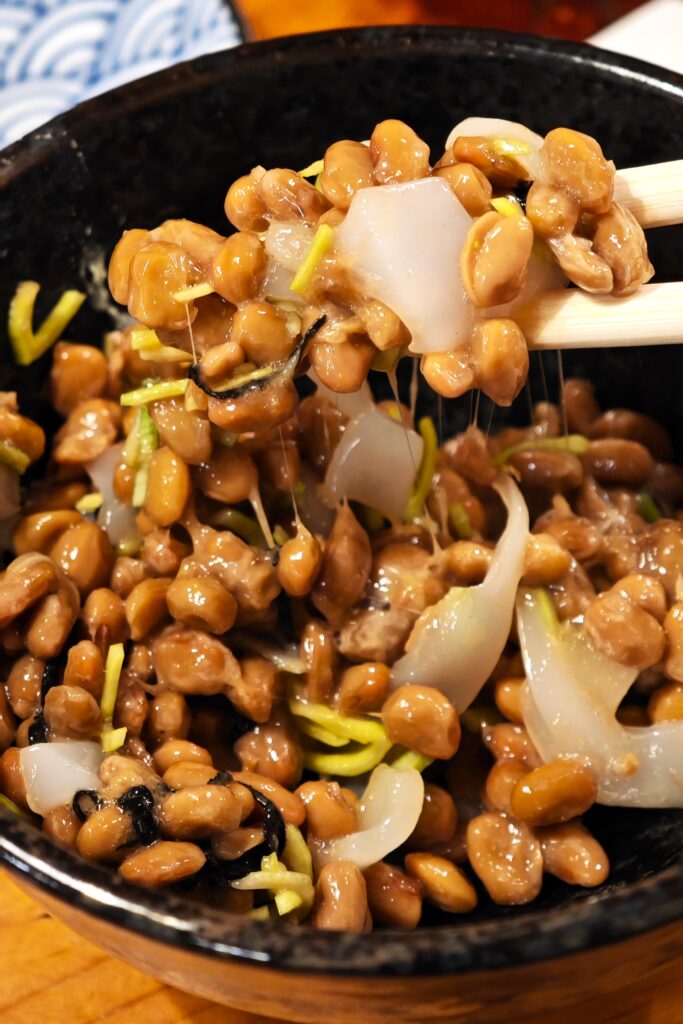
Adding to it is the bright yellow Japanese mustard (karashi). Unlike the Western mustard, it has a cleaner, sharper heat without the vinegar tang. Its spicy kick complements the earthy natto and fresh squid, adding a layer of complexity and flavor.
Stirring the natto before eating is a must, as it enhances the dish’s creaminess and ensures every element is evenly coated.
Natto is considered a superfood in Japan, beloved for its flavor and for its health benefits. It’s rich in protein, fiber, and probiotics, which promote gut health and aid digestion. It’s also a great source of vitamin K2, which supports bone health and cardiovascular function. In Japanese culture, natto is often a breakfast staple, paired with rice or other simple sides to kick-start the day with nourishment and energy. So give it a try if you want something truly Japanese and are open to bold, adventurous flavors.
Tempura, or deep-fried seafood or vegetables in a light, airy batter, is a cherished staple in Japan. Introduced in the 16th century by Portuguese missionaries, it has since become one of the country’s most popular dishes. At Mikura, you can savor tempura made with fresh ingredients like eggplant, peppers, zucchini or shrimp.

Soba is another long-time favorite in Japan. Made from buckwheat flour, soba noodles are firm with a slightly nutty and earthy flavor. Low in calories and high in nutrients like fiber, protein, and essential amino acids, soba is praised for its health benefits. Traditionally, soba can be enjoyed cold with a dipping sauce, highlighting its clean and refreshing flavor, or warm in a comforting bowl of soup. Both options are available at Mikuni.
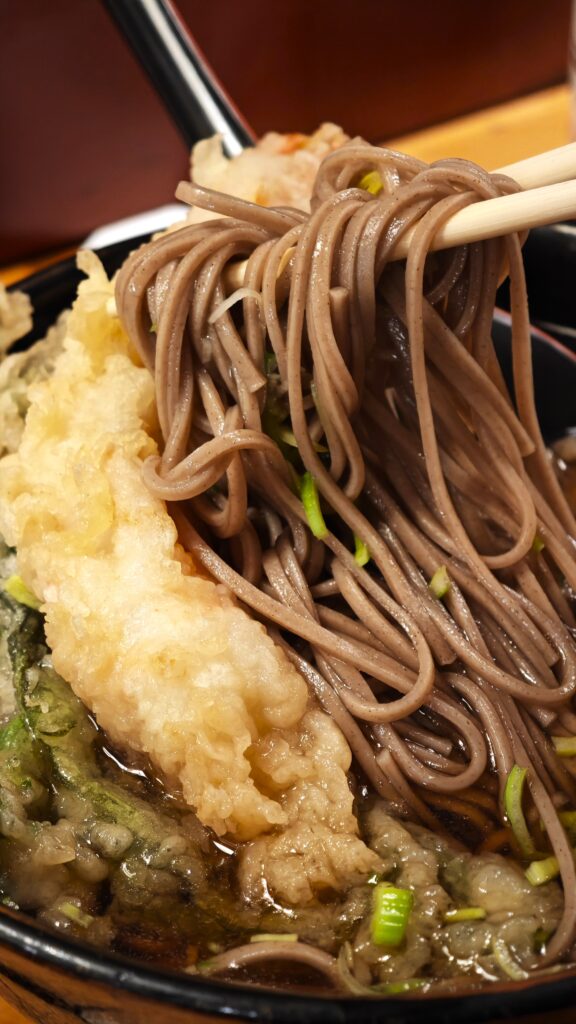
Combining these two culinary icons, we have the 天妇罗蕎麦 Tempura Soba. At Mikura, this dish features a bowl of warm, savory broth paired with soba noodles and a selection of tempura – tender, sweet shrimp; soft, buttery eggplant; mildly spicy, juicy pepper; comforting potato; sweet, earthy carrots; and light zucchini – each encased in a golden, crunchy shell that crackles with every bite.
The broth is umami and delicately sweet, made from a dashi base (a Japanese stock with kombu seaweed and bonito flakes), soy sauce, and mirin. This light yet flavorful soup pairs perfectly with the nutty soba noodles. Green onions lend a fresh, sharp note, while the tempura resting on top enriches the soup naturally, as the batter bits (tenkasu) dissolve into the broth.

Mikuni’s sushi truly stands out, offering different combos priced between 20 – 40 EUR. We’ll be highlighting the combo 特上寿司 Bestes Sushi (10 Nigiri, 1 Roll of 6 Pieces), as it includes most of our favorite sushi.
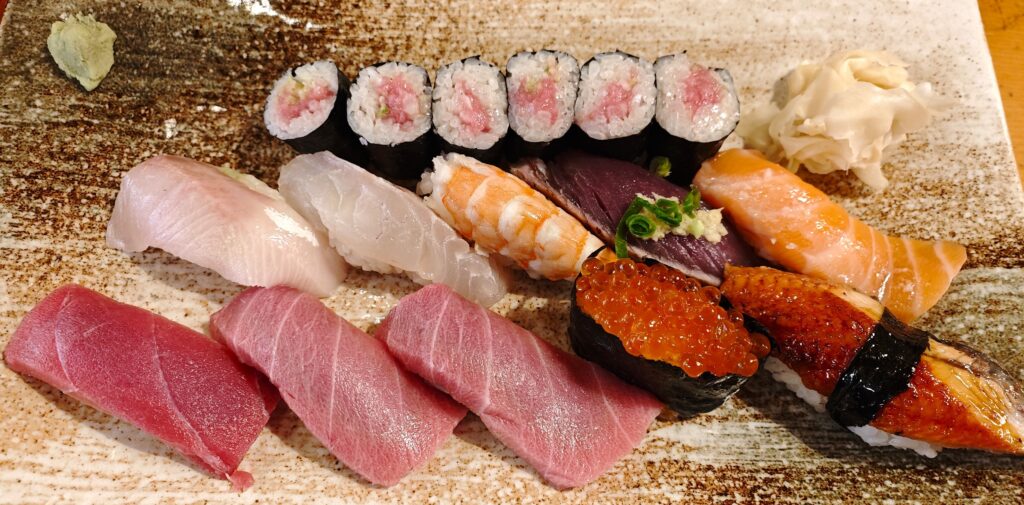
At Mikuni, the nigiri strikes an exceptional balance between the fish and rice. The fish is incredibly fresh, generously thick, and expertly sliced with subtle diagonal cuts that enhance the mouthfeel. It creates a tender bite, with just enough resistance to feel satisfying. Beneath the fish lies a little freshly grated wasabi, which lends a clean, mild heat.
The rice is lightly seasoned, imparting a gentle tanginess and sweetness. It’s molded into compact portions that don’t dominate, but act as a supporting base, ensuring that the focus remains on fish’s natural flavor.
The Lineup:
Maguro (Tuna): Deep red and slightly firm, offering a clean, rich sea flavor with a hint of iron.

Chutoro (Medium-Fat Tuna): Soft and buttery, it melts in your mouth, delivering waves of delicate richness.

Ohtoro (Fattest Tuna): very indulgent, pillowy, bursting with luscious fat and fresh umami.
Tai (Sea Bream): Mildly sweet with a subtle bloom of oceanic flavor, offering a refined taste.

Hirame (Flounder): Slightly chewy with a clean, sweet taste that gently spreads across the palate.
Shake (Salmon): The salmon belly, topped with lemon juice and sea salt, is buttery, savory with a hint of tang and indulgent silkiness. It needs no extra dipping sauce.

Unagi (Eel): Lightly flamed with teriyaki sauce, it’s tender, juicy, smoky, and umami-packed with a light sweetness.

Ebi (Shrimp): Slightly cooked and mildly flavored, offering a sweet, light, and plump bite.

Katsuo (Bonito): A bit firmer with a mild sea flavor, slightly metallic in its finish.

Ikura (Salmon Roe): Popping bursts of salty, savory, and juicy flavors, an intriguing contrast in texture and taste to other nigiri.

The Roll (Negitoro Maki) features chopped fatty tuna (negitoro) mixed with scallions, creating a tender, almost creamy filling. The fat of the tuna gives such a luxurious mouthfeel, wonderfully balanced by the fresh, sharp scallions. It’s like a silky explosion of flavor!
Mikuni’s wasabi is strong – just a touch too much might bring tears to your eyes! Yet it’s essential for balancing the richness of the fish. To fully enjoy the flavors, mix it well with soy sauce, dip the fish side of the nigiri upside down to avoid oversaturation, and let the fish touch your palate first; now savor its silkiness as it oozes with unparalleled freshness!

Gari (pickled ginger) is served as a palate cleanser between bites to refresh your taste buds. This sushi plate also comes with a hot cup of tea, a miso soup, and two refreshing vegetable sides.

Chirashi, a bowl of sushi rice topped with various sliced raw fish and seafood, is a popular staple in Japan. The name “chirashi” means “scattered” in Japanese, reflecting the artful presentation of fresh ingredients atop a bed of sushi rice. Chirashi at Mikuni is served with wasabi, gari (pickled ginger), and kani (crab stick). Priced between 20 – 42 EUR, the cost varies based on the fish assortment.
Das Beste Sortiment – 特上ちらし Tokujo Chirashi is certainly an attraction here, drawing sushi fans who come specifically just for this dish. The assortment includes light and fluffy Tamago (sweet egg omelet), delicately sweet and comforting; tender Kani (crab stick), with a subtle oceanic sweetness; and firm Katsuo (bonito), offering a slightly smoky, briny richness. The Suzuki (sea bass) delivers a clean and smooth taste with a mild sweetness, while Tai (sea bream) adds a refined oceanic note.

Adding to the variety are rich, buttery Chutoro (medium-fat tuna); creamy, luscious Ohtoro (fattest tuna); silky Shake (salmon); lightly sweet Ebi (shrimp); briny, slightly chewy, and sweet Hokki (surf clam). Juicy Ikura (salmon roe) brings savory bursts of oceanic flavor with its popping texture, while creamy Hotate (scallop) rounds out the assortment with its sweet and smooth finish.



The sushi rice is masterfully prepared. Subtly seasoned with rice vinegar, sugar, and salt, the rice itself is lightly tangy and sweet. Mixed with tobiko (flying fish roe) and finely chopped kani, it tastes fresh and umami-rich, with a slightly sweet and salty oceanic flavor. Toppings of nori and chopped tamago add crunch and a comforting, creamy sweetness, rounding out the sea flavors.

The artistically precise and colorful medley is as stunning as it’s delicious. Chirashi really embodies the spirit of Japanese cuisine: simple and refined, fresh and indulgent.

Mikuni isn’t just a sushi haven. There’s so much more to explore—from savory tapas and succulent grilled fish to hearty rice bowls, warm soups, noodle dishes, and delicious grilled skewers. However, if sushi is what you’re after, Mikuni is one of the best in Frankfurt. There are also lunch menus with a smaller selection of dishes. Be sure to reserve ahead—whether for dinner or lunch—because a walk-in could leave you without a seat or with a limited dining time. But we believe a visit to Mikuni is definitely worth planning ahead for!
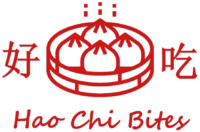
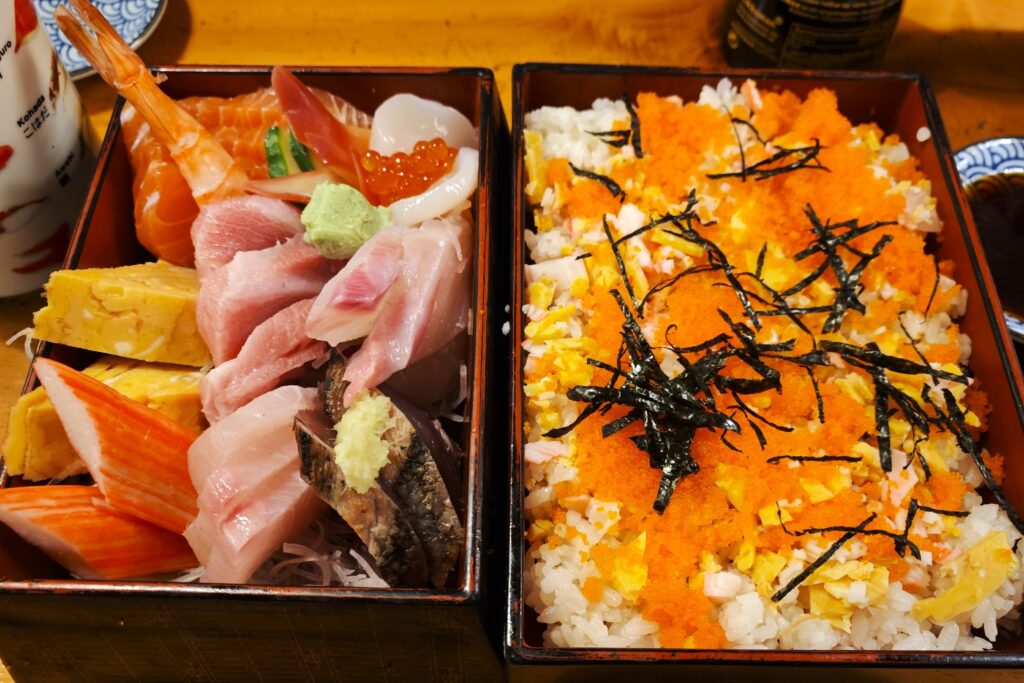
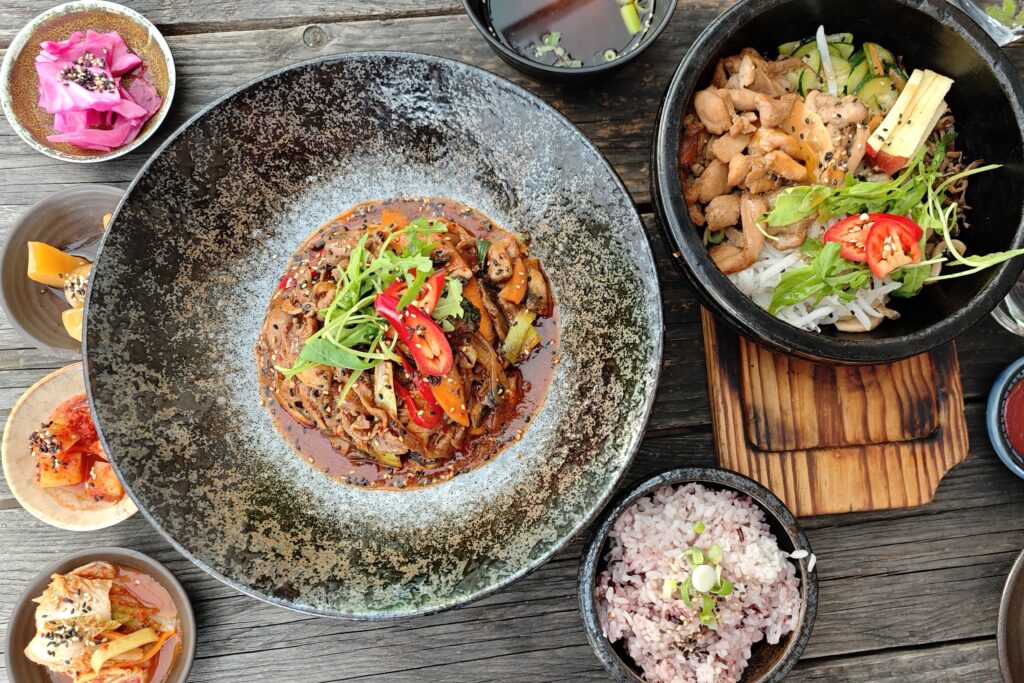
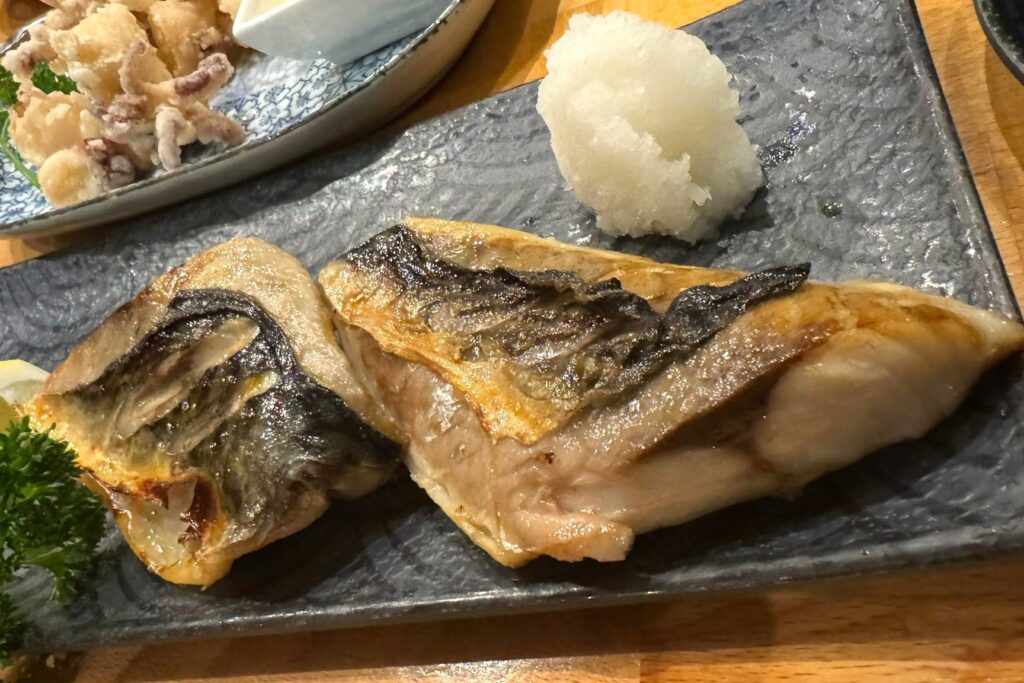
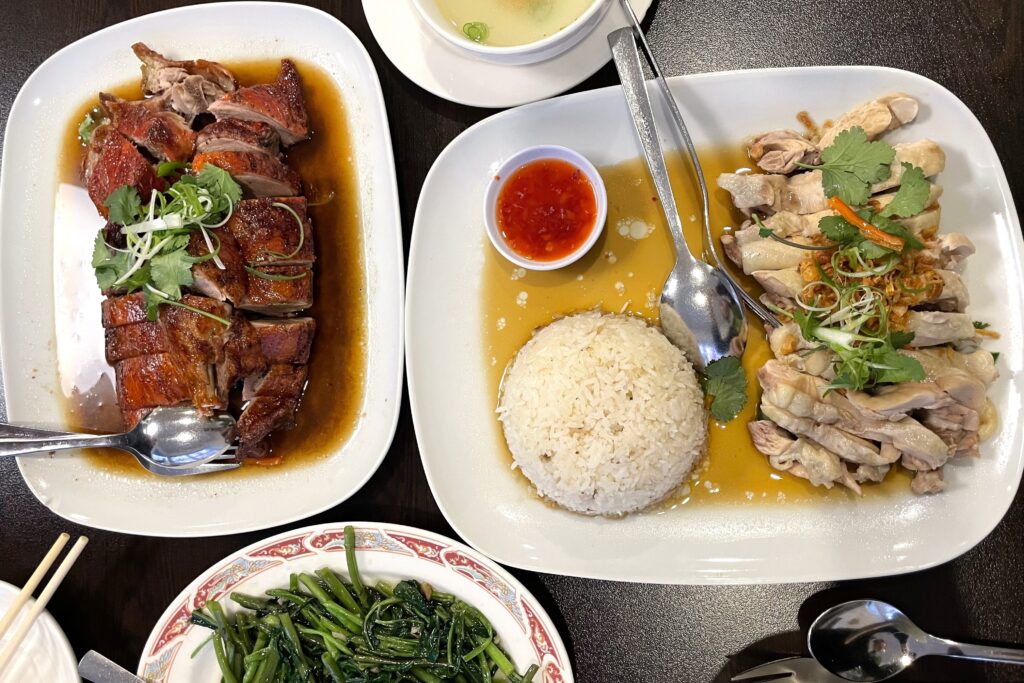
Really amazing and authentic sushi at great prices compared to other Japanese spots in Frankfurt. The mussel nigiri and salmon teriyaki are also absolute must-tries!
Thanks for sharing! It was the best sushi I’ve ever had! My friend even said it beats what she had in Japan. Always packed, so reservations are a must.